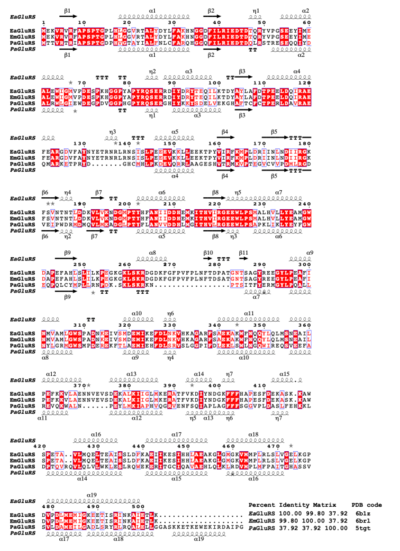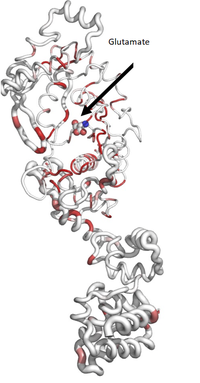Journal:Acta Cryst F:S2053230X22007555
From Proteopedia

Crystal structures of glutamyl-tRNA synthetase from Elizabethkingia anopheles and E. meningosepticumLauryn Brooks, Sandhya Subramanian, David M. Dranow, Stephen J. Mayclin, Peter J. Myler, and Oluwatoyin A. Asojo [1] Molecular Tour has a HUP-domain (orange), a Zn-binding-domain (green), and an anticodon binding domain (blue). The HUP domain and Zn-binding domain make up the N-terminal tRNA synthetases binding domain that binds the glutamate (spheres). . Mg2+ ion from EaGluRS is shown as a green sphere, glutamate molecule shown as spheres (colored by atoms with white, carbons, red, oxygen, and blue nitrogen spheres), formate and ethylene glycol from crystallization are shown as sticks (atoms colored in CPK).
EmGluRS shares ~97% sequence identity with EaGluRS but less than 39% sequence identity with any other structures in the Protein Data Bank. EmGluRS and EaGluRS have prototypical bacterial GluRS topology. EmGluRS and EaGluRS have similar binding sites and tertiary structures to other bacterial GluRS that are promising drug targets. These structural similarities can be exploited for drug discovery.  Structural and primary sequence alignment of EaGluRS, EmGluRS, and PaGluRS. The secondary structure elements are as follows: α- helices are shown as large coils, 310 helices are shown in small coils labeled η, beta-strand are shown in arrows labeled β, and beta-turns are labeled TT. The identical residues are shown on a red background with conserved residues in red and conserved regions in blue boxes. colored by sequence conservation with red indicating identical residues. Atoms of glutamate are colored in CPK. of PaGluRS (pdb entry 5tgt, yellow), EmGluRS (gray), and EaGluRS (cyan).
References
| |||||||||||

